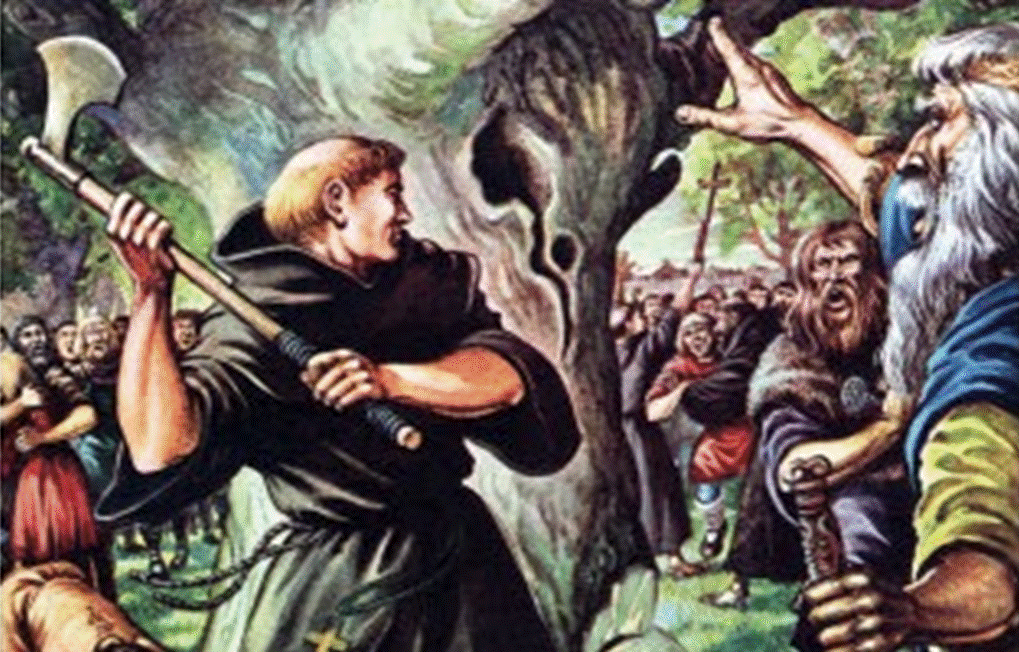Boniface – Martyr & Apostle of Germany (AD 680 – 754)

Boniface was born in England which at that time was dominated by the Anglo Saxons, who had largely been exposed to the Gospel by Augustine. His parents were nominal Christians. However, from a very early age Boniface had a burning desire to serve God. He was educated in a monastery and took the vows of a monk and adopted that lifestyle.
When he was 36 years old, in the year 716, he felt God calling him to be a missionary to the German Franks. He felt led to go to two areas of the Frankish empire known as Frisia & Saxony which were very much pagan regions.
The most holy place in these regions that Boniface was led to was called Mount Gutenberg. The pinnacle of the pagan worship there was at a huge oak tree which was known as ‘Thor’s Oak’ and according to that pagan tradition, Thor (a hammer-wielding god associated with thunder, lightning, storms, oak trees, strength, the protection of mankind, and also hallowing and fertility) resided there.
Boniface went straight to ‘Thor’s Oak’ and urged the people worshipping at that place to turn away from this pagan god and to worship the True and living God. The people were not impressed by his suggestion and so Boniface told them to come back and he would challenge their god Thor and show them that they should worship the true God and His Son, the Lord Jesus Christ.
A very large crowd turned up at the appointed day for the challenge and were looking forward to witness how Thor would really teach this man Boniface a lesson that he would never forget (probably involving lots of thunder and lightning & very, very frightening).
To the horror of those watching, Boniface, who had turned up with an axe, started to chop down the oak tree. The onlookers were mortified and expected Boniface to be immediately struck down with a huge thunderbolt of lightning. Of course, there was no thunder and lightning and it took Boniface the best part of a day to finally chop the huge oak tree down.
It then dawned on the huge crowd that their god, Thor, was powerless to stop this relatively puny monk from chopping down this tree. Boniface preached the Gospel to them and as a result many people decided to turn away from their pagan practices and instead began to believe in and worship this God that Boniface was telling them about. Indeed, many were baptised that very day. Thousands were baptised later and admitted into the Christian church.
Boniface actually used the wood from the felled ‘Thor’s Oak’ to build a church and thus completely turning the previous pagan worship site and practise around to adopt the worship of the True and living God.
After this, Boniface laboured for many years bringing the Gospel to this region of the Franks being heavily supported by Charles Martel.
A great part of his work was carried out in administration. However, towards the end of his life he moved away from administration and returned to his first passion of being a missionary of the Gospel to people who had never heard it before. This led him into an area in Frisia which was highly influenced by pagan practices. His work was marked with great success but there was frequently a violent reaction towards it.
On 5th June 754, Boniface was waiting in the neighbourhood of Dokkum, for the arrival of a number of newly converted Christians. They were suddenly attacked by an angry group of pagans and Boniface and his fifty companions were killed.
Thus, by martyrdom, was the life ended of an incredible missionary whose ministry really began with such similarity to the account of Elijah challenging the Baal worshippers in 1 Kings chapter 18.
